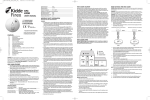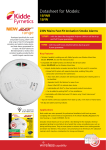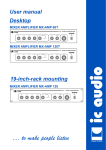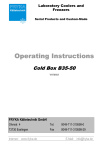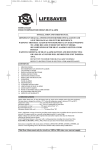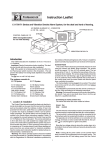Download USER'S MANUAL
Transcript
Page 1 IMPORTANT SAFETY INFORMATION PLEASE READ AND SAVE THESE INSTRUCTIONS 57°C TEMPERATURE RATING 4899 (H230CT) LOOSE BATTERY 4892 (HR230CT) RECHARGEABLE BS5446 pt 2: 2003 LICENSE NO. KM503753 PLEASE READ AND SAVE THIS MANUAL Installer: Please leave this manual with the occupier (or, in the case of a house in multiple operation, with the owner). CONTENTS p.1 p.1 p.2 p.3 p.3 p.4 p.5 p.5 p.5 p.5 p.6 p.7 p.7 p.7 p.7 p.8 p.8 Heat Alarm Features Specifications Important Safety Information Heat Alarm Location Heat Alarm Siting How to Install This Heat Alarm Interconnecting Heat Alarms Red and Green LED Indicators False Alarm Control Testing the Heat Alarm Maintenance, Cleaning,and Battery replacement-4899 only Repair Fire Safety Rules and Preventing Hazardous Situations Fire Procedure What to Do in Case of Fire Troubleshooting Guarantee !WARNING: HEAT ALARMS ALONE ARE NOT SUFFICIENT FOR LIFE SAFETY AS THEY ARE NOT DESIGNED TO DETECT SMOKE. THEY ARE INTENDED TO DETECT TEMPERATURES OF 57°C AND ABOVE TO PROVIDE AN ADDITIONAL SOURCE OF INFORMATION THAT IS SUPPLEMENTARY TO THAT PROVIDED BY SMOKE ALARMS TO INCREASE THE PROBABILITY THAT AN EARLY WARNING WILL BE PROVIDED AND SO ENHANCE LIFE SAFETY AND PROPERTY PROTECTION. SEE HEAT ALARMS HAVE LIMITATIONS IN THE IMPORTANT SAFETY INFORMATION SECTION OF THIS MANUAL. HEAT ALARM FEATURES • This heat alarm is powered from a 230V AC supply, and has a DC battery back-up source. AC/DC heat alarms offer added protection in the event of a power failure. • Unique power connector prevents interconnecting with incompatible heat alarms, smoke alarms, or security systems. • Item 4892 and 4899 heat alarms can be interconnected with eachother and as many as 23 other Firex heat alarms or Firex 230V AC smoke alarms. Interconnectable Firex smoke alarms include: 4870, 4973, 4881, 5086 and 4985. • Hush quiets unwanted alarms for up to 10 minutes. • 4892 includes permanent rechargeable lithium batteries. • Optional use tamper-resistant feature serves as a safeguard against tampering. • The heat alarm will sound a short beep about once a minute if the battery is low. • Multi-purpose green and red LEDs indicate that the heat alarm is connected to the AC supply, is working normally, or is in alarm. • Loud alarm sounder – 85 decibels [dB(A)] at 3m – will sound to alert you to an emergency. • Test button checks heat alarm operation. SPECIFICATIONS ITEM (MODEL NUMBER) ELECTRICAL RATING INTERCONNECTING FIREX SMOKE AND HEAT ALARMS (OR PATTRESS WITH RELAY) 4899 (H230CT), 4892 (HR230CT) 230V AC, DC BACK UP (4899: 9V REPLACEABLE, 4892: RECHARGABLE) UP TO ANY COMBINATION OF 23 OTHER FIREX HEAT ALARMS (MODEL 4889, 4892) OR FIREX SMOKE ALARMS (MODELS 4870, 4881, 4973, 5086 AND 4985) OR KIDDE 123/9HI,123/9HILL, 223/9HI,223/9HILL, 323/9HI + 323/9HILL ALARMS. !WARNING • The 4892 (HR230CT) requires constant 230V AC power AND fully charged batteries to operate properly. It requires 2 full days under mains power to reachfull back up capacity. The batteries are not replaceable. Heat alarm to any other type of device except those listed in this manual. • The 4899 (H230CT) heat alarm requires constant 230V AC power AND a healthy 9V DC battery to operate properly. This heat alarm WILL NOT work if AC power is not connected, or has failed or been interrupted for any reason, AND the batteries have been removed or are flat or improperly connected. DO NOT use any other kind of battery except as specified in this manual. Heat alarm to any other type of device except those listed in this manual. • The TEST/FALSE ALARM CONTROL button accurately tests all heat alarmfunctions. DO NOT use any other test method for routine testing. Test heat alarm weekly to ensure proper operation. • Higher ceilings will increase the time needed by the heat alarm to detect a fire. In most dwellings the ceiling height will keep this reac tion time within acceptable limits. However, ceilings with a height of over 6m may delay the reaction time of the heat alarm significantly. Advice from your local distributor or Fire Brigade should be obtained when installing a heat alarm on a ceiling higher than 6m. • This heat alarm should be installed only by a qualified electrician. The installation should comply with BS 7671 and all prevailing local, regional and national codes. • This heat alarm is designed to be used only as part of the protection of a single family dwelling or a house in multiple occupation (HMO) of no more than two stories. It also may be used in conjunction with smoke alarms within individual flats or apartments in larger houses in multiple occupation, to provide an early warning to occupants of a fire in a room within the dwelling, but a communal fire alarm system also should be provided in such cases. DO NOT install this heat alarm in any other buildings, such as hotels, motels, dormitories, hospitals, nursing homes or group homes of any kind. In these occupancies, a complete automatic fire detection and alarm system, complying with BS 5839: Part 1, should be installed. • Heat alarms should be used only in conjunction with smoke alarms, with which the heat alarms should be interconnected, in order to provide early warning of heat, smoke, or fire. Smoke alarms should be installed on every level of the dwelling. • Interconnected heat alarms and smoke alarms offer maximum protection. By interconnecting heat alarms and smoke alarms, when one unit senses heat, smoke, or fire, and sounds its alarm, all others will sound as well. DO NOT connect this heat alarm to any other type of alarm except those stated in this manual or an approved auxiliary device. • Heat alarms interconnected with smoke alarms may not alert every household member every time. The alarm sounder of the heat alarm is loud in order to alert individuals of a potential danger. However, there may be limiting circumstances where an occupant may not hear the alarm (e.g., outdoor or indoor noise, sound sleepers, drug or alcohol usage, impaired hearing, etc.). Household members must hear the alarm’s warning sound and quickly respond to it to reduce the risk of damage, injury, or death that may result from fire. • Check carefully that, when any one device operates, the alarm signal given by interconnected devices is clearly audible throughout the building, particularly in bedrooms, where it is essential that the alarm signal will wake sleeping occupants. • This heat alarm can sound an alarm only when it detects temperatures of 57°C or above. Heat alarms do not sense smoke or gas. In some fires, hazardous levels of toxic chemicals and smoke can build up before a heat alarm will operate. Temperatures may not reach 57°C to activate the heat alarm QUICKLY ENOUGH to ensure safe escape. • Some fires are slow smouldering, low heat-producing, or are in a different room to that in which the heat alarm is located, or the heat from the fire may bypass the alarm – the heat alarm may not give a warning under these circumstances. • HEAT ALARMS HAVE LIMITATIONS. This heat alarm is not guaranteed to protect lives or property. Heat alarms are not a substitute for insurnce. Householders should insure their lives and property. In addition, as with any electronic device, it is possible for the heat alarm to fail at any time. • Never paint this heat alarm. !DANGER: ELECTRIC SHOCK HAZARD. TURN OFF POWER TO THE HEAT ALARM CIRCUIT AT THE MAIN DIS- TRIBUTION BOARD BY REMOVING THE FUSE OR SWITCHING THE CIRCUIT BREAKER TO THE OFF POSITION AND SECURING IT. !WARNING: THIS HEAT ALARM SHOULD BE INSTALLED ONLY BY A QUALIFIED ELECTRICIAN IN ACCORREGULATIONS FOR ELECTRICAL INSTALLATIONS PUBLISHED BY THE INSTITUTION OF ELECTRICAL ENGINEERS (BS 7671) AND/OR ALL PRESIDING LOCAL, REGIONAL AND NATIONAL CODES. DANCE WITH THE !WARNING: HEAT ALARMS SHOULD BE CONNECTED ON A SINGLE INDEPENDENT, DEDICATED CIRCUIT AT THE MAIN DISTRIBUTION BOARD. NO OTHER ELECTRICAL EQUIPMENT, EXCEPT COMPATIBLE SMOKE AND CO ALARMS, SHOULD BE CONNECTED TO THIS CIRCUIT. IF YOUR HOME HAS RESIDUAL CURRENT DEVICE PROTECTION ON THE ELECTRICAL INSTALLATION OR ON INDIVIDUAL CIRCUITS, CHECK WITH A QUALIFIED ELECTRICIAN TO MAKE SURE THAT FAULTS ON CIRCUITS SERVING SOCKET OUTLETS OR PORTABLE APPLIANCES CANNOT CAUSE INTERRUPTION TO THE SUPPLY TO THE HEAT ALARMS. 1. Route the household AC supply/interconnect cable into the dry lining box or Firex surface pattress. 2. Using a suitably-rated terminal block, connect the neutral supply to the blue lead of the connector plug. Standard Dry Lining box or Firex pattress Standard Dry Lining box or Firex pattress CEILING CEILING NEUTRAL 70°C PAR230 LINE INTERLINK TO HOW TO INSTALL THIS HEAT ALARM Heat alarms give an audible warning when the temperature at the alarm reaches 57°C. Heat alarms are ideal for kitchens, garages, cellars, boiler rooms, attics and other areas where there are normally high levels of fumes, smoke or dust which preclude the use of smoke alarms due to the risk of false alarms. Guidance on fire detection in dwellings is contained in BS 5839: Part 6. For normalsized bungalows, two-story houses, flats and maisonettes, the British Standard recommends that the minimum level of protection should comprise smoke alarms in the hallways and staircases. This minimum standard necessitates one smoke alarm in the hallway of a typical bungalow or one smoke alarm on each level of a two-story house. Heat alarms should not be used in these circulation areas. If there are, for example, long hallways, even the minimum standard may necessitate additional interconnected smoke alarms. If, however, the design of the dwelling does not comply with modern fire safety standards, or if factors such as the presence of several young children, or elderly occupants or disabled people, or of smokers, the use of portable heaters or solid fuel fires during the night, or the use of electric blankets, particularly by the elderly, the British Standard advises that additional detection devices, installed within rooms, may be necessary. The British Standard recommends that, if the risk justifies the provision of detectors in a kitchen, boiler room, or other area (except a circulation area) in which smoke alarms would be likely to give false alarms, heat alarms should be used. However, the Standard also advises that heat alarms may be installed in other rooms instead of smoke alarms, provided that the construction enclosing the room (including the door) can resist fire for a sufficient time after operation of a heat alarm to enable occupants to escape safely. However, a heat alarm is unlikely to operate early enough to save the life of anyone asleep in the room in which it is installed. Moreover, a heat alarm in the room of fire origin may not give sufficient warning for occupants to escape safely if the door to that room is open. A Heat Alarm is also recommended in the Living Room, if a smoke alarm in that location, suffers nuisance alarms from smokers. BLUE -30°C 50 M2 5.3M 7.7M 6M HEAT ALARM LOCATION BROWN ORANGE OR WHITE USER’S MANUAL 57°C 37.8°C NEUTRAL 4899 4892 TEMPERATURE RATING MAXIMUM AMBIENT TEMPERATURE RATING OPERATING TEMPERATURE RECOMMENDED COVERAGE RECOMMENDED SPACING MAXIMUM DISTANCE FROM WALL MAXIMUM CEILING HEIGHT BLUE 9:11 AM PAR230 LINE INTERLINK 2010.1.29 BROWN ORANGE OR WHITE 1003-7201-01_(4899_4892)_V3:_ HEAT ALARM SITING FOR BEST PROTECTION, IT IS RECOMMENDED THAT YOU INSTALL A SMOKE OR HEAT ALARM IN EVERY ROOM. In addition, it is recommended that all smoke and heat alarms should be interconnected. 4892 HEAT ALARM OPTICAL ALARM ATTIC OFFICE IONISATION ALARM BEDROOM BEDROOM LIVING ROOM KITCHEN UTILITY/ LAUNDRY GARAGE Install heat alarm on a standard dry lining box or Firex pattress as close to the centreof the ceiling as possible. If the centre is not practical, mount the heat alarm no closer than 300mm away from a wall or corner. In rooms with open joists or beams, all ceiling-mounted alarms should be located on the bottom of such joists or beams and not up in joist channels. On sloped, peaked or gabled ceilings, install heat alarm 90cm from highest point. If only wall placement is possible, install no further than 150mm from ceiling. DO NOT install heat alarms: • Directly over the cooker, stove or oven. • In areas with high humidity, like bathrooms or shower rooms, or areas near dishwashers or washing machines. Install heat alarms at least 3m away from these areas if possible. • Adjacent to, or directly above, heaters, air-conditioning vents or ceiling fans. • In an area where the temperature may fall below -30°C or rise above 37°C. • Near fluorescent lights. Electrical noise and flickering may affect the operation of the heat alarm. • Closer than 300mm to light fittings. • In such a position that it is difficult or dangerous to reach for testing or maintenance. • Do not site the alarm in an area where water or other liquids may enter the alarm. 4899 3. Using a suitably-rated terminal block, (supplied with Firex pattresses),connect the line supply to the brown lead of the connector plug. 4. If interconnecting is desired, connect the orange or white of the connector plug to the designated interconnect conductor of the household cable. See note INTERCONNECTING HEAT ALARMS. NOTE: If this is to be a single-station heat alarm, connect the orange or white wire to an unused terminal block 5. Insert the completed connector block onto the mounting pins of the Firex Pattress or recess into dry lining box. 6. For the 4899 ONLY: a. Open the battery compartment door. b. Connect a new, healthy 9V DC battery to the battery connector inside the battery compartment. Be sure the battery is securely connected. The heatalarm may beep briefly when the battery is installed. c. Close the battery compartment door, snapping it into place. 7. Pass the connector plug through the mounting plate of the heat alarm, align slots and fasten mounting plate securely to the Firex Pattress or dry lining box. NOTE: If this is to be a single-station heat alarm, connect the orange or white wire to an unused terminal block 8. Attach the connector plug to the pins on the back of the heat alarm. The plug will only fit one way, and will snap into place. 9. Gently tug the connector to be sure it is attached securely. 10. Position the heat alarm on the mounting plate and turn it clockwise to lock it into place. 11. Turn on the power to the heat alarm circuit at the main distribution board. 12. Test the heat alarm for AC operation. See TESTING THE HEAT ALARM. 1003-7201-01_(4899_4892)_V3:_ 2010.1.29 9:11 AM Page 2 INTERCONNECTING HEAT ALARMS Use 1.5mm2 minimum solid or stranded cable with a rating of 230V. When interconnecting heat alarms and/or smoke alarms, the maximum cable length between any two should be 450m for 1.5mm2 cable (20 ohm loop resistance.) This heat alarm may be interconnected with as many as 23 other Firex Model 4899 or 4892 heat alarms or model 4870, 4881, 4973, 4985 or 5086 smoke alarms. DO NOT connect to any other type or model of heat alarm or smoke alarm. Connect all interconnectedheat and smoke alarms to a single final circuit. Wiring must conform to I.E.E. Regulations for Electrical Installations (BS 7671). 2. Firmly depress the TEST/Hush button for at least five (5) seconds. The heat alarm will sound a loud beep for about four (4) times a second. The alarm may sound for up to ten (10) seconds after the TEST/Hush button is released. NOTE: If heat alarms are interconnected, all heat and smoke alarms should sound an alarm within three (3) seconds after any test button is pushed and the tested heat alarm sounds. 3. If the heat alarm does not sound, turn off the power to the heat alarm circuit at the main distribution board and check the wiring. Retest the heat alarm. !WARNING: IF THE HEAT ALARM SOUNDS, AND THE HEAT ALARM IS NOT BEING TESTED, THE HEAT ALARM IS SENSING A TEMPERATURE OF 57°C OR ABOVE. THE ALARM SOUND REQUIRES YOUR IMMEDIATE ATTENTION AND ACTION. EVACUATE THE DWELLING IMMEDIATELY! MAINTENANCE AND CLEANING In addition to weekly testing, this heat alarm must be cleaned periodically to remove dust, dirt and debris. !DANGER: ELECTRIC SHOCK HAZARD. BLUE ORANGE OR WHITE BROWN BLUE NEUTRAL ORANGE OR WHITE BROWN FOR INTERCONNECTING: USE A MINIMUM OF LINE 1.5mm2 CABLE NOTE: Colors shown correspond to electrical codes in the United Kingdom. Colors may vary in other countries. RED AND GREEN LED INDICATORS This heat alarm features a red and green LED indicator that can be seen through the clear light pipe on the top of alarm. The LEDs indicate the following: GREEN ON – AC power is present. OFF – AC power is not present. RED BLINKS ONCE A MINUTE – DC power is present indicating normal operation. BLINKS SIX TIMES PER MINUTE – False Alarm Control activated. OFF – DC power is not present. BLINKS ONCE A SECOND and unit is sounding alarm – senses 57°C temperature or greater. OFF and unit is sounding alarm – Another interconnected smoke/heat alarm in the network has sensed smoke or 57°C and is signaling this alarm. HUSH CONTROL !WARNING: BEFORE USING THE ALARM’S HUSH FEATURE, FULLY IDENTIFY THE SOURCE OF THE HEAT BUILD UP AND MAKE SURE THAT THE AREA IS SAFE. TO ACTIVATE CONTROL PUSH AND RELEASE THE TEST/FALSE ALARM CONTROL BUTTON IN THE CENTER OF THE ALARM. THE ALARM WILL SILENCE IMMEDIATELY AND THE RED LIGHT (LED) WILL BLINK APPROXIMATELY EVERY 10 SECONDS FOR THE NEXT 10 MINUTES. THIS FEATURE IS TO BE USED ONLY WHEN A SAFE CONDITION IS KNOWN TO EXIST. The Hush feature will silence the alarm for approximately 10 minutes. A rapid rise in temperature will override the False Alarm Control and cause the unitto sound an alarm. After 10 minutes the heat alarm will beep twice. This signals the end of Hush Control period and the unit will revert to normal operation. If the unit still detects a dangerous situation the alarm will sound again. If interconnected alarms are installed, the unit that detects the high temperature and sounds the alarm cannot be inadvertently silenced by the TEST/Hush button of other units. In this case all of the alarms will continue to sound for as long as a dangerous situation is detected or until the TEST/Hush button of the initiating alarm is pressed. If the alarm does not go into False Alarm Control and continues to sound its alarm, the heat in the area is too high and a dangerous situation may exist – take emergency action. TESTING THE HEAT ALARM !WARNING: TEST EACH HEAT ALARM AND SMOKE ALARM TO BE SURE THAT EACH IS INSTALLED CORRECTLY AND IS OPERATING PROPERLY. THE ALARM SOUNDER IS LOUD TO ALERT YOU TO AN EMERGENCY AND CAN BE HARMFUL TO HEARING. TEST THE HEAT ALARM WEEKLY AND UPON RETURNING FROM HOLIDAY, OR WHEN THE HOUSE HAS BEEN UNOCCUPIED FOR SEVERAL DAYS. STAND AT ARM’S LENGTH FROM THE HEAT ALARM WHEN TESTING. Test all heat alarms weekly by doing the following: 1. Check the TEST/HUSH button. If the green LED above the test button is ON, the heat alarm is receiving AC power. REPAIR !CAUTION: DO NOT ATTEMPT TO REPAIR THIS HEAT ALARM. DOING SO WILL INVALIDATE YOUR GUARANTEE. If the heat alarm is not operating properly, see TROUBLESHOOTING. If necessary, and if the heat alarm is still under warrant, pack it in a well-padded carton and send it, with Proof of Purchase postage prepaid, to the address given at the end of this manual. If the heat alarm is no longer under guarantee, have a qualified electrician replace the heat alarm immediately with a comparable Firex brand heat alarm. 5. Keep doors and windows closed unless you open them to escape. FIRE SAFETY RULES AND PREVENTING HAZARDOUS SITUATIONS Siting, testing, and taking care of heat and smoke alarms is just one step in helping to protect your family and home from fires. You must also reduce the chance that fires will start in your home and increase your chances of escaping if a fire does start. At a minimum, your home fire safety program should include the following guidelines: • Use smoking materials properly – never smoke in bed or when sleepy or under the influence of alcohol or other drugs. !WARNING: HEAT ALARMS ARE LIFE-SAVING DEVICES AND SHOULD BE CARED FOR PERIODICALLY • Keep matches and other sources of ignition away from children. CLEANING • Store flammable materials in proper containers and never store or use them near open flames or sparks. !WARNING: BATTERIES NOT REPLACEABLE IN THE 4892. MODEL 4892 HAS PERMANENTLY MOUNTED RECHARGEABLE LITHIUM BATTERIES THAT ARE DESIGNED TO LAST THE USEFUL LIFE OF THE ALARM. BATTERY REPLACEMENT– 4899 ONLY Always turn off the AC power to the heat alarm before replacing the battery. Replace the battery at least once annually, or immediately when the low battery signal sounds once a minute, even though the heat alarm is receiving AC power. Use only the following batteries as replacements in this heat alarm: Eveready 522 or 1222, Duracell MN1604 or Ultralife UL9V-J. !CAUTION: DANGER OF EXPLOSION IF BATTERY IS INCORRECTLY REPLACED. USE ONLY THE BATTERIES SPECIFIED IN THE USER MANUAL. NOT USE ANY OTHER TYPE OF BATTERY, EXCEPT AS SPECIFIED IN THIS MANUAL. DO NOT USE RECHARGEABLE BATTERIES. !WARNING: DO 1. Turn off the AC power supply to the heat alarm at the main distribution board. 2. Insert a small screwdriver into the slot in the mounting plate and turn the heat alarm counterclockwise to detach the alarm. 3. Gently pull down the heat alarm. Be careful not to separate any wire connections. 4. Pull out the connector plug from the back of the heat alarm. 5. From the back of the heat alarm, remove battery door screw and lift the tab to open the battery compartment door. 6. Remove the battery from the compartment. Disconnect the drained battery from the battery compartment and discard. 13. Turn on the AC power and test the heat alarm using the TEST button. See TESTING THE HEAT ALARM. TROUBLESHOOTING • Do not allow rubbish to accumulate. • Have the electrical wiring in your house checked by a qualified electrician at least every 10 years (or more often as it ages). • Never leave cooking unattended. FIRE PROCEDURE If you hear the heat or smoke alarm sounding, and you have not pushed the test button, it is warning you of a dangerous situation. You will need to respond immediately. To prepare for such occurrences, develop family escape plans, discuss them with all household members, and practice them regularly. For your safety, as a minimum, you should do the following to have more effective fire safety. • Draw a floor plan of your home and find all ways to escape if there is a fire. On the ground floor, consider whether windows can be used for escape. On upper floors, consider whether external rescue will be possible if escape routes are blocked by fire or smoke. • Expose everyone to the sounds of the heat alarm and of the smoke alarm and explain what the sounds mean. Show them how to check to see if doors are hot before opening them, how to stay close to the floor and crawl along the floor to stay below dangerous smoke, fumes and gases, and how to use the alternative exit if a door is hot. Instruct them not to open the door if the door is hot. • Hold fire drills every six (6) months to make sure everyone, even small children, know what to do to escape safely. 12. Reattach the heat alarm to the mounting plate by turning the heat alarm clockwise until it snaps into place. These guidelines will assist you in the event of a fire. However, to reduce the chance that fires will start, practice fire safety rules and prevent hazardous situations. Contact your local Fire Brigade for more information. • Keep portable heaters and open flames such as candles away from combustible materials. 9. Close the battery compartment door. Push down until it snaps into place. Install battery door screw. 11. Replace the connector plug. The connector will snap into place. Gently tug the connector to be sure it is attached properly. 8. Always call the Fire Brigade as soon as possible, even if a fire seems small. • Keep fireplaces, chimneys, and barbecue grills clean, and make sure they are properly sited away from combustible materials. 8. Place the battery into the battery compartment. 10. Using the TEST button, test the heat alarm to verify 9V DC battery back-up. See TESTING THE HEAT ALARM. 7. Call the Fire Brigade as soon as possible from outside your house. Give your full address, including the name of the town or village. • Keep electrical appliances and their leads in good working condition, and do not overload electrical circuits. • Decide on a meeting place a safe distance from your house and make sure all members of your household understand they should go and wait for you there if there is a fire. Explain to children that they must be ready to leave the house by themselves if necessary. 7. Connect a new, healthy 9V battery to the connector. The battery will fit only one way. Be sure the battery connector is securely attached to the battery terminals. 6. Meet at your pre-arranged meeting place after leaving the house. 9. Never re-enter a burning or smoke-filled building. TURN OFF THE AC SUPPLY TO THE HEAT ALARM AT THE MAIN DISTRIBUTION BOARD BY REMOVING THE FUSE OR SWITCHING THE APPROPRIATE CIRCUIT BREAKER TO THE OFF POSITION BEFORE CLEANING THE HEAT ALARM. Clean the heat alarm at least once annually to remove dust, dirt and debris. Always turn off the AC power to the heat alarm before cleaning it. Using the soft brush or wand attachment to a vacuum cleaner, vacuum all sides and the cover of the heat alarm. Be sure that all vents are free from debris. If necessary, turn off the AC power and use a cloth dampened with warm water to clean the heat alarm cover. IMPORTANT: Do not attempt to remove the cover or clean inside the heat alarm. THIS WILL INVALIDATE YOUR GUARANTEE. Failure to properly clean and maintain this heat alarm may result in impaired operation and possible failure and will invalidate the guarantee. gaps round the room door to stop smoke from entering until help arrives. 4. Stay close to the floor; smoke and hot gases rise toward the ceiling. • Know where to go to call the Fire Brigade from outside your house. • Provide emergency equipment, such as fire extinguishers, and teach your family how and when to use this equipment. WHAT TO DO IN CASE OF A FIRE After you have prepared family escape plans and practiced them with your family, you have increased their chances of escaping safely. Review the following rules with your family when you have fire drills, so everyone will remember them in a real fire. 1. Don’t panic, stay calm. Your safe escape may depend on thinking clearly and remembering what you have practiced. 2. Get out of the house, following your planned escape route, as quickly as possible. Do not stop to collect anything or to get dressed. 3. Open doors carefully only after feeling to see if they are hot. Do not open a door if it is hot; use an alternative escape route. If your escape route is blocked, go to a window and shout for help. If necessary, stuff clothing or other materials in the GUARANTEE Kidde Safety Europe (the “Company”) guarantees this product to be free from defects in material and workmanship under normal use and service (“Defects”) for a period of six (6) years from the date of purchase (the “Guarantee Period”). Should any Defects be discovered within the Guarantee Period, the Company will, at its option, repair or replace the defective product provided that: (a) it is returned during the Guarantee Period with postage prepaid and with proof of purchase date to the address shown below and (b) the Company verifies that the claim is proper. This Guarantee does not cover damage resulting from accident, improper installation, maintenance or repair, misuse, abuse or product modification. This Guarantee does not confer any rights other than those expressly set out above and does not cover any claims for consequential loss or damage. This Guarantee is offered as an extra benefit and does not affect your statutory rights as a consumer. Return units in a padded carton, postage prepaid, to: KIDDE SAFETY EUROPE LIMITED Mathisen Way Colnbrook, Berkshire SL3 0HB United Kingdom Tel.: +44 (0) 1753 685148 www.smoke-alarms.co.uk 1003-7201-01


